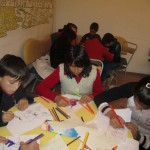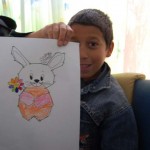Feedback as Validation
Correct.
Incorrect.
Almost.
Try again.
These statements regularly begin feedback statements built into Web-based courses we produce. Feedback is an essential part of any training, and yet, I wonder how much we really think about the quality of feedback offered. Some recent events in my personal life have helped me rethink my instructional approach to course feedback.
 From Oct. 2-Oct. 15, I travelled to Gabrovo, Bulgaria, to work as a volunteer at an orphanage. Many people have heard about orphanages in Romania and Bulgaria, and they usually think of images of babies without love who would turn their faces to the wall, turning from life and hope. My experience was with orphans ages 8 to 18, but I quickly came to see that they were in desperate need of love. The organization I volunteered with One Heart Bulgaria helps with many orphanages throughout Bulgaria. A friend and I were assigned to a home with 27 children who attended school during the day, and we spent the afternoons and evenings with them.
From Oct. 2-Oct. 15, I travelled to Gabrovo, Bulgaria, to work as a volunteer at an orphanage. Many people have heard about orphanages in Romania and Bulgaria, and they usually think of images of babies without love who would turn their faces to the wall, turning from life and hope. My experience was with orphans ages 8 to 18, but I quickly came to see that they were in desperate need of love. The organization I volunteered with One Heart Bulgaria helps with many orphanages throughout Bulgaria. A friend and I were assigned to a home with 27 children who attended school during the day, and we spent the afternoons and evenings with them.
Before going any further, I need to generously thank Allen Communication for allowing me to take time off for this experience. They were great to work with me as I fulfilled a personal goal in my life.
I can hardly begin to capture the breadth and depth of learning I was immersed in for two weeks, and yet the overwhelming feeling of growth and learning I received stems from interactions with the children. These children go to public school and return to the home around 3 p.m. each day. There are 2-3 workers there to help with homework, particularly for the children ages 8-12. Then, one worker stays on shift until dinner. After dinner, the all-night worker comes on shift. So, for the majority of their time, the children outnumber the staff 27 to 1. There are also full-time employees who work in the office. All the employees provide the very best support and attention they can to the children, there simply aren’t the necessary resources to provide more one-on-one attention.
 The result is that the children act as parents, siblings, and friends to each other. They discipline each other, and they operate under a distinct order of age and size. At first, many of the 14-18 year olds didn’t reach out to us. In contrast, the younger children quickly welcomed us into their routines and their hearts. It was with them that I first started to notice patterns in behavior relating to their need for validation and recognition. Raucho, 8, loved to color and draw. He would take a coloring page and fastidiously sit and color, his tongue usually emerging as his intensity increased. About half way through the picture, he would raise his picture and shout at me—no matter where I was in the group room—“Breanne, Breanne… look!” I answered, “Good job, Raucho!” He would continue, interrupting his rigor for periodic show and shout to me. I never got tired of cheering him on.
The result is that the children act as parents, siblings, and friends to each other. They discipline each other, and they operate under a distinct order of age and size. At first, many of the 14-18 year olds didn’t reach out to us. In contrast, the younger children quickly welcomed us into their routines and their hearts. It was with them that I first started to notice patterns in behavior relating to their need for validation and recognition. Raucho, 8, loved to color and draw. He would take a coloring page and fastidiously sit and color, his tongue usually emerging as his intensity increased. About half way through the picture, he would raise his picture and shout at me—no matter where I was in the group room—“Breanne, Breanne… look!” I answered, “Good job, Raucho!” He would continue, interrupting his rigor for periodic show and shout to me. I never got tired of cheering him on.
For others, the validation was different. Camela, 11, would dance and perform for us. She loved the applause and the hug that would follow. Andre, 16, loved order and process. He made sure we always had everything we needed. He always wanted me to joke with him… often calling for a joke on demand. Valia, 14, is an amazing soccer player. At first she seemed all confidence, and yet even she lit up when praised her sport skills. Sasho, 16, usually seemed too busy to play with us, and yet one evening he sat and played a game with me for about 40 minutes. He was so happy to win and feel the excitement of being victor.
 I could name each child and how I learned to show them recognition and to praise them. Maybe I never realized that not having parents or guardians would remove praise and validation. They quickly absorbed all the praise and care we could offer. And, why wouldn’t they? Don’t we all need to be validated? To be recognized and praised? I’m 30, and I still need it. A sincere compliment or phrase of praise still makes my day. It makes us feel capable and it even enables us to move forward with confidence.
I could name each child and how I learned to show them recognition and to praise them. Maybe I never realized that not having parents or guardians would remove praise and validation. They quickly absorbed all the praise and care we could offer. And, why wouldn’t they? Don’t we all need to be validated? To be recognized and praised? I’m 30, and I still need it. A sincere compliment or phrase of praise still makes my day. It makes us feel capable and it even enables us to move forward with confidence.
I’ve been thinking a lot about this concept as I’ve returned to work. I feel these same principles apply to all types of learning. We need be aware of the feedback and the validation we give learners. Each client has different demographics for their learners, and yet I feel safe in saying that all clients want their employees to succeed. They develop training to teach and to inspire. I think that the feedback should be directly related to the business goals at hand.
As an instructional design consultant, I want to be more cognizant of the types of feedback and validation I write into courses. And, hopefully, I will succeed at giving better feedback and validation to the people in my personal life as well.





